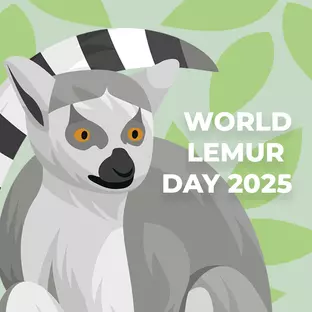
Lemurs
Volunteer with Lemurs
Found only in the wild in Madagascar, lemurs are unusual, captivating, and essential to the health of the island’s delicate forest ecosystems. As natural seed dispersers, lemurs play a vital role in regenerating forests and supporting countless other species. Yet despite their importance, lemurs are facing a silent crisis. According to the latest IUCN Red List, a staggering 98% of lemur species are now endangered, with populations declining at an alarming rate.
Volunteering with lemurs in Madagascar offers a rare chance to actively contribute to their survival through hands-on conservation research. Unlike sanctuary-based volunteering, lemur conservation research projects focus on protecting wild populations in their natural habitats. As a volunteer, you’ll be working directly with field researchers, assisting with wildlife monitoring, behavioural studies, habitat assessments, and biodiversity surveys. Your efforts will help collect critical data that supports long-term strategies to save these extraordinary primates and the ecosystems they call home. By volunteering with lemurs, you’re not just saving a species, you’re helping to preserve the heartbeat of Madagascar’s forests.
Projects Do More
13 - 27 Nights from $1,614.00 $1,452.00
Step into a real-world conservation adventure. The Lemur Research Project in Madagascar offers volunteers the opportunity to work alongside experts in protecting critically endangered wildlife and the forests they call home.
View projectOn the Blog
Lemurs Information
Lemurs At A Glance
Endangered Status
Dependent on Species - Ranging Vulnerable to Critically Endangered
Number remaining in the wild
Dependent on Species
Endemic Region
Madagascar
The majority of lemur species on the IUCN Red List are endangered. This is primarily due to human-driven threats, with the following being the most significant:
- Habitat Destruction: Deforestation is the greatest threat to lemurs. Vast areas of Madagascar’s forests are being cleared for slash-and-burn agriculture, illegal logging, charcoal production, and cattle grazing. As their natural habitat disappears, lemurs lose essential food sources, shelter, and migration pathways, leaving them increasingly isolated and vulnerable.
- Hunting and Poaching: Lemurs are frequently hunted for bushmeat in Madagascar, particularly in areas where food insecurity is high. Traditional beliefs that once protected lemurs are eroding, leading to increased hunting pressure.
- Illegal Wildlife Trade: Lemurs, especially smaller species, are often captured and sold as exotic pets or used in tourist attractions, despite national and international protections. The pet trade not only removes individuals from wild populations but also contributes to inhumane treatment and poor survival rates in captivity.
- Habitat Fragmentation: Remaining forest areas are increasingly fragmented into small, disconnected patches. This limits lemurs’ ability to find food, mates, and shelter, and it significantly reduces genetic diversity, increasing the risk of population collapse.
- Climate Change: Rising temperatures, shifting rainfall patterns, and extreme weather events are disrupting Madagascar’s fragile ecosystems. Climate change reduces food availability, alters breeding cycles, and puts additional stress on already declining lemur populations.
- Human-Wildlife Conflict: As human settlements expand into lemur habitats, conflicts between humans and these primates are becoming increasingly common. In some areas, lemurs raid crops, prompting retaliation from local farmers. Negative interactions can result in injury or death for lemurs and further strain relationships between communities and conservation efforts.
- Invasive Species: Invasive species introduced to Madagascar, such as rats, dogs, and cats, prey on lemurs or compete with them for food. These invasive animals also spread diseases that lemurs are not equipped to handle, further threatening their survival.
Lemur conservation in Madagascar today relies on several key strategies: establishing and managing protected forests, restoring fragmented habitats by planting native tree species, running breeding programs to bolster genetic diversity, and engaging local communities, particularly through environmental education.
Researchers are conducting field studies on lemur behaviour, health, and population trends, ensuring that policy decisions and conservation plans are grounded in robust scientific data.
There’s lots we can do to help lemurs whether you’re on the ground in Madagascar or supporting from home. To help secure a future for lemurs:
- Support Credible Conservation Organisations: Donate or become a member of groups like the Lemur Conservation Foundation, Madagascar Biodiversity Partnership, or Wildlife Conservation Society, which fund protected‑area management, reforestation, and field research.
- Volunteer with Lemurs: Joining a lemur conservation research program offers a hands‑on way to protect lemurs, along with other extraordinary endemic wildlife that makes Madagascar so unique.
- Choose Sustainable Products: Avoid products linked to deforestation (e.g., illegally sourced rosewood or charcoal). Opt for sustainably certified goods and pressure companies to adopt zero‑deforestation supply chains.
- Stay Informed & Spread the Word: Follow scientific publications, conservation blogs, and reputable news outlets for the latest research on lemur status. The more people know, the stronger the global voice for their protection.
Volunteers support daily operations, contribute to habitat protection, assist with research, and help raise awareness about lemur conservation challenges, including deforestation and poaching.
The most prominent locations are in Madagascar, the lemurs’ native habitat. Some conservation centres, zoos, and sanctuaries in other countries may offer volunteering opportunities with lemurs.





